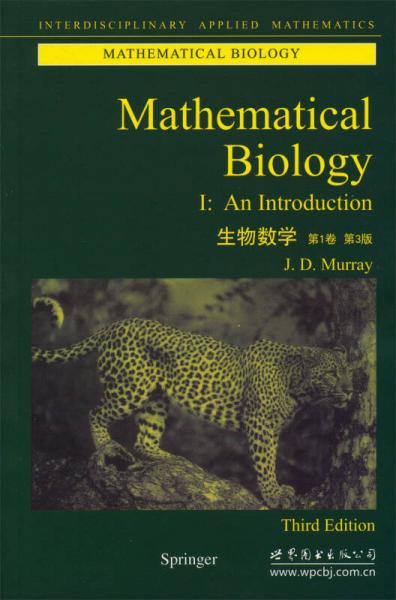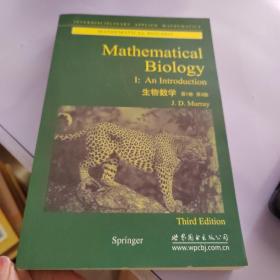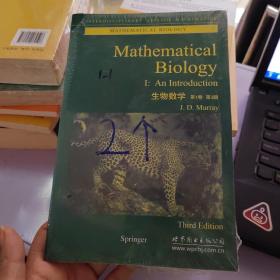生物数学·第1卷(第3版)
出版时间:
2013-01
版次:
1
ISBN:
9787510052767
定价:
89.00
装帧:
平装
开本:
24开
纸张:
胶版纸
页数:
551页
正文语种:
英语
-
《生物数学·第1卷(第3版)》是近代生物数学方面的名著。这是第一卷,第三版,在原来版本的基础上做了全面修订。近年来这个科目的茁壮成长和新知识点的不断涌现,新的版本将原来的一卷集分成上下两卷,扩大了知识容量,第二卷绝大多数是新增知识点。书中对生物学中的反应扩散方程和形态发生学的数学理论及最新研究成果作了全面介绍,是学习与研究生物数学的一部不可多得的参考书。 contents,volumei
prefacetothethirdedition
prefacetothefirstedition
1.continuouspopulationmodelsforsinglespecies
1.1continuousgrowthmodels
1.2insectoutbreakmodel:sprucebudworm
1.3delaymodels
1.4linearanalysisofdelaypopulationmodels:periodicsolutions
1.5delaymodelsinphysiology:periodicdynamicdiseases
1.6harvestingasinglenaturalpopulation
1.7populationmodelwithagedistribution
exercises
2.discretepopulationmodelsforasinglespecies
2.1introduction:simplemodels
2.2cobwebbing:agraphicalprocedureofsolution
2.3discretelogistic-typemodel:chaos
2.4stability,periodicsolutionsandbifurcations
2.5discretedelaymodels
2.6fisherymanagementmodel
.2.7ecologicalimplicationsandcaveats
2.8tumourcellgrowth
exercises
3.modelsforinteractingpopulations
3.1predator-preymodels:lotka-volterrasystems
3.2complexityandstability
3.3realisticpredator-preymodels
3.4analysisofapredator-preymodelwithlimitcycleperiodicbehaviour:parameterdomainsofstability
3.5competitionmodels:competitiveexclusionprinciple
3.6mutualismorsymbiosis
3.7generalmodelsandcautionaryremarks
3.8thresholdphenomena
3.9discretegrowthmodelsforinteractingpopulations
3.10predator-preymodels:detailedanalysis
exercises
4.temperature-dependentsexdetermination(tsd)
4.1biologicalintroductionandhistoricalasidesonthecrocodilia.
4.2nestingassumptionsandsimplepopulationmodel
4.3age-structuredpopulationmodelforcrocodilia
4.4density-dependentage-structuredmodelequations
4.5stabilityofthefemalepopulationinwetmarshregionl
4.6sexratioandsurvivorship
4.7temperature-dependentsexdetermination(tsd)versusgeneticsexdetermination(gsd)
4.8relatedaspectsonsexdetermination
exercise
5.modellingthedynamicsofmaritalinteraction:divorcepredictionandmarriagerepair
5.1psychologicalbackgroundanddata:gottmanandlevensonmethodology
5.2maritaltypologyandmodellingmotivation
5.3modellingstrategyandthemodelequations
5.4steadystatesandstability
5.5practicalresultsfromthemodel
5.6benefits,implicationsandmarriagerepairscenarios
6.reactionkinetics
6.1enzymekinetics:basicenzymereaction
6.2transienttimeestimatesandnondimensionalisation
6.3michaelis-mentenquasi-steadystateanalysis
6.4suicidesubstratekinetics
6.5cooperativephenomena
6.6autocatalysis,activationandinhibition
6.7multiplesteadystates,mushroomsandisolas
exercises
7.biologicaloscillatorsandswitches
7.1motivation,briefhistoryandbackground
7.2feedbackcontrolmechanisms
7.3oscillatorsandswitcheswithtwoormorespecies:generalqualitativeresults
7.4simpletwo-speciesoscillators:parameterdomaindeterminationforoscillations
7.5hodgkin-huxleytheoryofnervemembranes:fitzhugh-nagumomodel
7.6modellingthecontroloftestosteronesecretionandchemicalcastration
exercises
8.bzoscillatingreactions
8.1belousovreactionandthefield-koros-noyes(fkn)model
8.2linearstabilityanalysisofthefknmodelandexistenceoflimitcyclesolutions
8.3nonlocalstabilityofthefknmodel
8.4relaxationoscillators:approximationforthebelousov-zhabotinskiireaction
8.5analysisofarelaxationmodelforlimitcycleoscillationsinthebelousov-zhabotinskiireaction
exercises
9.perturbedandcoupledoscillatorsandblackholes
9.1phaseresettinginoscillators
9.2phaseresettingcurves
9.3blackholes
9.4blackholesinrealbiologicaloscillators
9.5coupledoscillators:motivationandmodelsystem
9.6phaselockingofoscillations:synchronisationinfireflies
9.7singularperturbationanalysis:preliminarytransformation
9.8singularperturbationanalysis:transformedsystem
9.9singularperturbationanalysis:two-timeexpansion
9.10analysisofthephaseshiftequationandapplicationtocoupledbelousov-zhabotinskiireactions
exercises
10.dynamicsofinfectiousdiseases
10.1historicalasideonepidemics
10.2simpleepidemicmodelsandpracticalapplications
10.3modellingvenerealdiseases
10.4multi-groupmodelforgonorrheaanditscontrol
10.5aids:modellingthetransmissiondynamicsofthehumanimmunodeficiencyvirus(hiv)
10.6hiv:modellingcombinationdrugtherapy
10.7delaymodelforhivinfectionwithdrugtherapy
10.8modellingthepopulationdynamicsofacquiredimmunitytoparasiteinfection
10.9age-dependentepidemicmodelandthresholdcriterion
10.10simpledruguseepidemicmodelandthresholdanalysis
10.11bovinetuberculosisinfectioninbadgersandcaule
10.12modellingcontrolstrategiesforbovinetuberculosisinbadgersandcattle
exercises
11.reactiondiffusion,chemotaxis,andnoniocalmechanisms
11.1simplerandomwalkandderivationofthediffusionequation
11.2reactiondiffusionequations
11.3modelsforanimaldispersal
11.4chemotaxis
11.5nonlocaleffectsandlongrangediffusion
11.6cellpotentialandenergyapproachtodiffusionandlongrangeeffects
exercises
12.oscillator-generatedwavephenomena
12.ibelousov-zhabotinskiireactionkinematicwaves
12.2centralpatterngenerator:experimentalfactsintheswimmingoffish
12.3mathematicalmodelforthecentralpatterngenerator
12.4analysisofthephasecoupledmodelsystem
exercises
13.biologicalwaves:single-speciesmodels
13.lbackgroundandthetravellingwaveform
13.2fisher-kolmogoroffequationandpropagatingwavesolutions
13.3asymptoticsolutionandstabilityofwavefrontsolutionsofthefisher-kolmogoroffequation
13.4density-dependentdiffusion-reactiondiffusionmodelsandsomeexactsolutions
13.5wavesinmodelswithmulti-steadystatekinetics:spreadandcontrolofaninsectpopulation
13.6calciumwavesonamphibianeggs:activationwavesonmedakaeggs
13.7invasionwavespeedswithdispersivevariability
13.8speciesinvasionandrangeexpansion
exercises
14.useandabuseoffractals
14.1fractals:basicconceptsandbiologicalrelevance
14.2examplesoffractalsandtheirgeneration
14.3fractaldimension:conceptsandmethodsofcalculation
14.4fractalsorspace-filling?
appendices
a.phaseplaneanalysis
b.routh-hurwitzconditions,juryconditions,descartes'
ruleofsigns,andexactsolutionsofacubic
b.1polynomialsandconditions
b.2descartes'ruleofsigns
b.3rootsofageneralcubicpolynomial
bibliography
index
contents,volumeii
j.d.murray:mathematicalbiology,ii:spatialmodelsandbiomedicalapplications
prefacetothethirdedition
prefacetothefirstedition
1.multi-specieswavesandpracticalapplications
1.1intuitiveexpectations
1.2wavesofpursuitandevasioninpredator-preysystems
1.3competitionmodelforthespatialspreadofthegreysquirrelinbritain
1.4spreadofgeneticallyengineeredorganisms
1.5travellingfrontsinthebelousov-zhabotinskiireaction
1.6wavesinexcitablemedia
1.7travellingwavetrainsinreactiondiffusionsystemswithoscillatorykinetics
1.8spiralwaves
1.9spiralwavesolutionsofx-coreactiondiffusionsystems
2.spatialpatternformationwithreactiondiffusionsystems
2.1roleofpatterninbiology
2.2reactiondiffusion(turing)mechanisms
2.3generalconditionsfordiffusion-driveninstability:linearstabilityanalysisandevolutionofspatialpattern
2.4detailedanalysisofpatterninitiationinareactiondiffusionmechanism
2.5dispersionrelation,turingspace,scaleandgeometryeffectsinpatternformationmodels
2.6modeselectionandthedispersionrelation
2.7patterngenerationwithsingle-speciesmodels:spatialheterogeneitywiththesprucebudwormmodel
2.8spatialpatternsinscalarpopulationinteractiondiffusionequationswithconvection:ecologicalcontrolstrategies
2.9nonexistenceofspatialpatternsinreactiondiffusionsystems:generalandparticularresults
3.animalcoatpatternsandotherpracticalapplicationsofreactiondiffusionmechanisms
3.1mammaliancoatpatterns--'howtheleopardgotitsspots'
3.2teratologies:examplesofanimalcoatpatternabnormalities
3.3apatternformationmechanismforbutterflywingpatterns
3.4modellinghairpatternsinawhorlinacetabularia
4.patternformationongrowingdomains:alligatorsandsnakes
4.istripepatternformationinthealligator:experiments
4.2modellingconcepts:determiningthetimeofstripeformation
4.3stripesandshadowstripesonthealligator
4.4spatialpatterningofteethprimordiainthealligator:backgroundandrelevance
4.5biologyoftoothinitiation
4.6modellingtoothprimordiuminitiation:background
4.7modelmechanismforalligatorteethpatterning
4.8resultsandcomparisonwithexperimentaldata
4.9predictionexperiments
4.10concludingremarksonalligatortoothspatialpatterning
4.11pigmentationpatternformationonsnakes
4.12cell-chemotaxismodelmechanism
4.13simpleandcomplexsnakepatternelements
4.14propagatingpatterngenerationwiththeceli-chemotaxissystem
5.bacterialpatternsandchemotaxis
5.1backgroundandexperimentalresults
5.2modelmechanismfore.coliinthesemi-solidexperiments
5.3liquidphasemodel:intuitiveanalysisofpatternformation
5.4interpretationoftheanalyticalresultsandnumericalsolutions
5.5semi-solidphasemodelmechanismfors.typhimurium
5.6linearanalysisofthebasicsemi-solidmodel
5.7briefoutlineandresultsofthenonlinearanalysis
5.8simulationresults,parameterspaces,basicpatterns
5.9numericalresultswithinitialconditionsfromtheexperiments
5.10swarmringpatternswiththesemi-solidphasemodelmechanism
5.11branchingpatternsinbacillussubtilis
6.mechanicaltheoryforgeneratingpatternandformindevelopment
6.1introduction,motivationandbackgroundbiology
6.2mechanicalmodelformesenchymalmorphogenesis
6.3linearanalysis,dispersionrelationandpatternformationpotential
6.4simplemechanicalmodelswhichgeneratespatialpatternswithcomplexdispersionrelations
6.5periodicpatternsoffeathergerms
6.6cartilagecondensationinlimbmorphogenesisandmorphogeneticrules
6.7embryonicfingerprintformation
6.8mechanochemicalmodelfortheepidermis
6.9formationofmicrovilli
6.10complexpatternformationandtissueinteractionmodels
7.evolution,morphogeneticlaws,developmentalconstraintsandteratologies
7.1evolutionandmorphogenesis
7.2evolutionandmorphogeneticrulesincartilageformationinthevertebratelimb
7.3teratologies(monsters)
7.4developmentalconstraints,morphogeneticrulesandtheconsequencesforevolution
8.amechanicaltheoryofvascularnetworkformation
8.1biologicalbackgroundandmotivation
8.2cell-extracellularmatrixinteractionsforvasculogenesis
8.3parametervalues
8.4analysisofthemodelequations
8.5networkpatterns:numericalsimulationsandconclusions
9.epidermalwoundhealing
9.1briefhistoryofwoundhealing
9.2biologicalbackground:epidermalwounds
9.3modelforepidermalwoundhealing
9.4nondimensionalform,linearstabilityandparametervalues
9.5numericalsolutionfortheepidermalwoundrepairmodel
9.6travellingwavesolutionsfortheepidermalmodel
9.7clinicalimplicationsoftheepidermalwoundmodel
9.8mechanismsofepidermalrepairinembryos
9.9actinalignmentinembryonicwounds:amechanicalmodel
9.10mechanicalmodelwithstressalignmentoftheactinfilamentsintwodimensions
10.dermalwoundhealing
10.1backgroundandmotivation---generalandbiological
10.2logicofwoundhealingandinitialmodels
10.3briefreviewofsubsequentdevelopments
10.4modelforfibroblast-drivenwoundhealing:residualstrainandtissueremodelling
10.5solutionsofthemodelequationsolutionsandcomparisonwithexperiment
10.6woundhealingmodelofcook(1995)
10.7matrixsecretionanddegradation
10.8cellmovementinanorientedenvironment
10.9modelsystemfordermalwoundhealingwithtissuestructure
10.10one-dimensionalmodelforthestructureofpathologicalscars
10.11openproblemsinwoundhealing
10.12concludingremarksonwoundhealing
11.growthandcontrolofbraintumours
11.1medicalbackground
11.2basicmathematicalmodelofgliomagrowthandinvasion
11.3tumourspreadinvitro:parameterestimation
11.4tumourinvasionintheratbrain
11.5tumourinvasioninthehumanbrain
11.6modellingtreatmentscenarios:generalcomments
11.7modellingtumourresection(removal)inhomogeneoustissue
11.8analyticalsolutionfortumourrecurrenceafterresection
11.9modellingsurgicalresectionwithbraintissueheterogeneity
11.10modellingtheeffectofchemotherapyontumourgrowth
11.11modelingtumourpolyclonalityandcellmutation
12.neuralmodelsofpatternformation
12.1spatialpatterninginneuralfiringwithasimpleactivation-inhibitionmodel
12.2amcchanismforstripeformationinthevisualcortex
12.3amodelforthebrainmechanismunderlyingvisualhallucinationpatterns
12.4neuralactivitymodelforshellpatterns
12.5shamanismandrockart
13.geographicspreadandcontrolofepidemics
13.1simplemodelforthespatialspreadofanepidemic
13.2spreadoftheblackdeathineurope1347-1350
13.3briefhistoryofrabies:factsandmyths
13.4thespatialspreadofrabiesamongfoxesi:backgroundandsimplemodel
13.5spatialspreadofrabiesamongfoxesii:three-species(sir)model
13.6controlstrategybasedonwavepropagationintoanon-epidemicregion:estimateofwidthofarabiesbarrier
13.7analyticapproximationforthewidthoftherabiescontrolbreak
13.8two-dimensionalepizooticfrontsandeffectsotvariablefoxdensitics:quantitativepredictionsforarabiesoutbreakinengland
13.9effectoffoximmunityonspatialspreadofrabies
14.wolfterritoriality,wolf-deerinteractionandsurvival
14.1introductionandwolfecology
14.2modelsforwolfpackterritoryformation:singlepack--homerangemodel
14.3multi-wolfpackterritorialmodel
14.4wolf-deerpredator-preymodel
14.5concludingremarkson-wolfterritorialityanddeersurvival
14.6coyotehomerangepatterns
14.7chippewaandsiouxintertribalconflictc1750-1850
appendix
a.generalresultsforthelaplacianoperatorinboundeddomains
bibliography
index
-
内容简介:
《生物数学·第1卷(第3版)》是近代生物数学方面的名著。这是第一卷,第三版,在原来版本的基础上做了全面修订。近年来这个科目的茁壮成长和新知识点的不断涌现,新的版本将原来的一卷集分成上下两卷,扩大了知识容量,第二卷绝大多数是新增知识点。书中对生物学中的反应扩散方程和形态发生学的数学理论及最新研究成果作了全面介绍,是学习与研究生物数学的一部不可多得的参考书。
-
目录:
contents,volumei
prefacetothethirdedition
prefacetothefirstedition
1.continuouspopulationmodelsforsinglespecies
1.1continuousgrowthmodels
1.2insectoutbreakmodel:sprucebudworm
1.3delaymodels
1.4linearanalysisofdelaypopulationmodels:periodicsolutions
1.5delaymodelsinphysiology:periodicdynamicdiseases
1.6harvestingasinglenaturalpopulation
1.7populationmodelwithagedistribution
exercises
2.discretepopulationmodelsforasinglespecies
2.1introduction:simplemodels
2.2cobwebbing:agraphicalprocedureofsolution
2.3discretelogistic-typemodel:chaos
2.4stability,periodicsolutionsandbifurcations
2.5discretedelaymodels
2.6fisherymanagementmodel
.2.7ecologicalimplicationsandcaveats
2.8tumourcellgrowth
exercises
3.modelsforinteractingpopulations
3.1predator-preymodels:lotka-volterrasystems
3.2complexityandstability
3.3realisticpredator-preymodels
3.4analysisofapredator-preymodelwithlimitcycleperiodicbehaviour:parameterdomainsofstability
3.5competitionmodels:competitiveexclusionprinciple
3.6mutualismorsymbiosis
3.7generalmodelsandcautionaryremarks
3.8thresholdphenomena
3.9discretegrowthmodelsforinteractingpopulations
3.10predator-preymodels:detailedanalysis
exercises
4.temperature-dependentsexdetermination(tsd)
4.1biologicalintroductionandhistoricalasidesonthecrocodilia.
4.2nestingassumptionsandsimplepopulationmodel
4.3age-structuredpopulationmodelforcrocodilia
4.4density-dependentage-structuredmodelequations
4.5stabilityofthefemalepopulationinwetmarshregionl
4.6sexratioandsurvivorship
4.7temperature-dependentsexdetermination(tsd)versusgeneticsexdetermination(gsd)
4.8relatedaspectsonsexdetermination
exercise
5.modellingthedynamicsofmaritalinteraction:divorcepredictionandmarriagerepair
5.1psychologicalbackgroundanddata:gottmanandlevensonmethodology
5.2maritaltypologyandmodellingmotivation
5.3modellingstrategyandthemodelequations
5.4steadystatesandstability
5.5practicalresultsfromthemodel
5.6benefits,implicationsandmarriagerepairscenarios
6.reactionkinetics
6.1enzymekinetics:basicenzymereaction
6.2transienttimeestimatesandnondimensionalisation
6.3michaelis-mentenquasi-steadystateanalysis
6.4suicidesubstratekinetics
6.5cooperativephenomena
6.6autocatalysis,activationandinhibition
6.7multiplesteadystates,mushroomsandisolas
exercises
7.biologicaloscillatorsandswitches
7.1motivation,briefhistoryandbackground
7.2feedbackcontrolmechanisms
7.3oscillatorsandswitcheswithtwoormorespecies:generalqualitativeresults
7.4simpletwo-speciesoscillators:parameterdomaindeterminationforoscillations
7.5hodgkin-huxleytheoryofnervemembranes:fitzhugh-nagumomodel
7.6modellingthecontroloftestosteronesecretionandchemicalcastration
exercises
8.bzoscillatingreactions
8.1belousovreactionandthefield-koros-noyes(fkn)model
8.2linearstabilityanalysisofthefknmodelandexistenceoflimitcyclesolutions
8.3nonlocalstabilityofthefknmodel
8.4relaxationoscillators:approximationforthebelousov-zhabotinskiireaction
8.5analysisofarelaxationmodelforlimitcycleoscillationsinthebelousov-zhabotinskiireaction
exercises
9.perturbedandcoupledoscillatorsandblackholes
9.1phaseresettinginoscillators
9.2phaseresettingcurves
9.3blackholes
9.4blackholesinrealbiologicaloscillators
9.5coupledoscillators:motivationandmodelsystem
9.6phaselockingofoscillations:synchronisationinfireflies
9.7singularperturbationanalysis:preliminarytransformation
9.8singularperturbationanalysis:transformedsystem
9.9singularperturbationanalysis:two-timeexpansion
9.10analysisofthephaseshiftequationandapplicationtocoupledbelousov-zhabotinskiireactions
exercises
10.dynamicsofinfectiousdiseases
10.1historicalasideonepidemics
10.2simpleepidemicmodelsandpracticalapplications
10.3modellingvenerealdiseases
10.4multi-groupmodelforgonorrheaanditscontrol
10.5aids:modellingthetransmissiondynamicsofthehumanimmunodeficiencyvirus(hiv)
10.6hiv:modellingcombinationdrugtherapy
10.7delaymodelforhivinfectionwithdrugtherapy
10.8modellingthepopulationdynamicsofacquiredimmunitytoparasiteinfection
10.9age-dependentepidemicmodelandthresholdcriterion
10.10simpledruguseepidemicmodelandthresholdanalysis
10.11bovinetuberculosisinfectioninbadgersandcaule
10.12modellingcontrolstrategiesforbovinetuberculosisinbadgersandcattle
exercises
11.reactiondiffusion,chemotaxis,andnoniocalmechanisms
11.1simplerandomwalkandderivationofthediffusionequation
11.2reactiondiffusionequations
11.3modelsforanimaldispersal
11.4chemotaxis
11.5nonlocaleffectsandlongrangediffusion
11.6cellpotentialandenergyapproachtodiffusionandlongrangeeffects
exercises
12.oscillator-generatedwavephenomena
12.ibelousov-zhabotinskiireactionkinematicwaves
12.2centralpatterngenerator:experimentalfactsintheswimmingoffish
12.3mathematicalmodelforthecentralpatterngenerator
12.4analysisofthephasecoupledmodelsystem
exercises
13.biologicalwaves:single-speciesmodels
13.lbackgroundandthetravellingwaveform
13.2fisher-kolmogoroffequationandpropagatingwavesolutions
13.3asymptoticsolutionandstabilityofwavefrontsolutionsofthefisher-kolmogoroffequation
13.4density-dependentdiffusion-reactiondiffusionmodelsandsomeexactsolutions
13.5wavesinmodelswithmulti-steadystatekinetics:spreadandcontrolofaninsectpopulation
13.6calciumwavesonamphibianeggs:activationwavesonmedakaeggs
13.7invasionwavespeedswithdispersivevariability
13.8speciesinvasionandrangeexpansion
exercises
14.useandabuseoffractals
14.1fractals:basicconceptsandbiologicalrelevance
14.2examplesoffractalsandtheirgeneration
14.3fractaldimension:conceptsandmethodsofcalculation
14.4fractalsorspace-filling?
appendices
a.phaseplaneanalysis
b.routh-hurwitzconditions,juryconditions,descartes'
ruleofsigns,andexactsolutionsofacubic
b.1polynomialsandconditions
b.2descartes'ruleofsigns
b.3rootsofageneralcubicpolynomial
bibliography
index
contents,volumeii
j.d.murray:mathematicalbiology,ii:spatialmodelsandbiomedicalapplications
prefacetothethirdedition
prefacetothefirstedition
1.multi-specieswavesandpracticalapplications
1.1intuitiveexpectations
1.2wavesofpursuitandevasioninpredator-preysystems
1.3competitionmodelforthespatialspreadofthegreysquirrelinbritain
1.4spreadofgeneticallyengineeredorganisms
1.5travellingfrontsinthebelousov-zhabotinskiireaction
1.6wavesinexcitablemedia
1.7travellingwavetrainsinreactiondiffusionsystemswithoscillatorykinetics
1.8spiralwaves
1.9spiralwavesolutionsofx-coreactiondiffusionsystems
2.spatialpatternformationwithreactiondiffusionsystems
2.1roleofpatterninbiology
2.2reactiondiffusion(turing)mechanisms
2.3generalconditionsfordiffusion-driveninstability:linearstabilityanalysisandevolutionofspatialpattern
2.4detailedanalysisofpatterninitiationinareactiondiffusionmechanism
2.5dispersionrelation,turingspace,scaleandgeometryeffectsinpatternformationmodels
2.6modeselectionandthedispersionrelation
2.7patterngenerationwithsingle-speciesmodels:spatialheterogeneitywiththesprucebudwormmodel
2.8spatialpatternsinscalarpopulationinteractiondiffusionequationswithconvection:ecologicalcontrolstrategies
2.9nonexistenceofspatialpatternsinreactiondiffusionsystems:generalandparticularresults
3.animalcoatpatternsandotherpracticalapplicationsofreactiondiffusionmechanisms
3.1mammaliancoatpatterns--'howtheleopardgotitsspots'
3.2teratologies:examplesofanimalcoatpatternabnormalities
3.3apatternformationmechanismforbutterflywingpatterns
3.4modellinghairpatternsinawhorlinacetabularia
4.patternformationongrowingdomains:alligatorsandsnakes
4.istripepatternformationinthealligator:experiments
4.2modellingconcepts:determiningthetimeofstripeformation
4.3stripesandshadowstripesonthealligator
4.4spatialpatterningofteethprimordiainthealligator:backgroundandrelevance
4.5biologyoftoothinitiation
4.6modellingtoothprimordiuminitiation:background
4.7modelmechanismforalligatorteethpatterning
4.8resultsandcomparisonwithexperimentaldata
4.9predictionexperiments
4.10concludingremarksonalligatortoothspatialpatterning
4.11pigmentationpatternformationonsnakes
4.12cell-chemotaxismodelmechanism
4.13simpleandcomplexsnakepatternelements
4.14propagatingpatterngenerationwiththeceli-chemotaxissystem
5.bacterialpatternsandchemotaxis
5.1backgroundandexperimentalresults
5.2modelmechanismfore.coliinthesemi-solidexperiments
5.3liquidphasemodel:intuitiveanalysisofpatternformation
5.4interpretationoftheanalyticalresultsandnumericalsolutions
5.5semi-solidphasemodelmechanismfors.typhimurium
5.6linearanalysisofthebasicsemi-solidmodel
5.7briefoutlineandresultsofthenonlinearanalysis
5.8simulationresults,parameterspaces,basicpatterns
5.9numericalresultswithinitialconditionsfromtheexperiments
5.10swarmringpatternswiththesemi-solidphasemodelmechanism
5.11branchingpatternsinbacillussubtilis
6.mechanicaltheoryforgeneratingpatternandformindevelopment
6.1introduction,motivationandbackgroundbiology
6.2mechanicalmodelformesenchymalmorphogenesis
6.3linearanalysis,dispersionrelationandpatternformationpotential
6.4simplemechanicalmodelswhichgeneratespatialpatternswithcomplexdispersionrelations
6.5periodicpatternsoffeathergerms
6.6cartilagecondensationinlimbmorphogenesisandmorphogeneticrules
6.7embryonicfingerprintformation
6.8mechanochemicalmodelfortheepidermis
6.9formationofmicrovilli
6.10complexpatternformationandtissueinteractionmodels
7.evolution,morphogeneticlaws,developmentalconstraintsandteratologies
7.1evolutionandmorphogenesis
7.2evolutionandmorphogeneticrulesincartilageformationinthevertebratelimb
7.3teratologies(monsters)
7.4developmentalconstraints,morphogeneticrulesandtheconsequencesforevolution
8.amechanicaltheoryofvascularnetworkformation
8.1biologicalbackgroundandmotivation
8.2cell-extracellularmatrixinteractionsforvasculogenesis
8.3parametervalues
8.4analysisofthemodelequations
8.5networkpatterns:numericalsimulationsandconclusions
9.epidermalwoundhealing
9.1briefhistoryofwoundhealing
9.2biologicalbackground:epidermalwounds
9.3modelforepidermalwoundhealing
9.4nondimensionalform,linearstabilityandparametervalues
9.5numericalsolutionfortheepidermalwoundrepairmodel
9.6travellingwavesolutionsfortheepidermalmodel
9.7clinicalimplicationsoftheepidermalwoundmodel
9.8mechanismsofepidermalrepairinembryos
9.9actinalignmentinembryonicwounds:amechanicalmodel
9.10mechanicalmodelwithstressalignmentoftheactinfilamentsintwodimensions
10.dermalwoundhealing
10.1backgroundandmotivation---generalandbiological
10.2logicofwoundhealingandinitialmodels
10.3briefreviewofsubsequentdevelopments
10.4modelforfibroblast-drivenwoundhealing:residualstrainandtissueremodelling
10.5solutionsofthemodelequationsolutionsandcomparisonwithexperiment
10.6woundhealingmodelofcook(1995)
10.7matrixsecretionanddegradation
10.8cellmovementinanorientedenvironment
10.9modelsystemfordermalwoundhealingwithtissuestructure
10.10one-dimensionalmodelforthestructureofpathologicalscars
10.11openproblemsinwoundhealing
10.12concludingremarksonwoundhealing
11.growthandcontrolofbraintumours
11.1medicalbackground
11.2basicmathematicalmodelofgliomagrowthandinvasion
11.3tumourspreadinvitro:parameterestimation
11.4tumourinvasionintheratbrain
11.5tumourinvasioninthehumanbrain
11.6modellingtreatmentscenarios:generalcomments
11.7modellingtumourresection(removal)inhomogeneoustissue
11.8analyticalsolutionfortumourrecurrenceafterresection
11.9modellingsurgicalresectionwithbraintissueheterogeneity
11.10modellingtheeffectofchemotherapyontumourgrowth
11.11modelingtumourpolyclonalityandcellmutation
12.neuralmodelsofpatternformation
12.1spatialpatterninginneuralfiringwithasimpleactivation-inhibitionmodel
12.2amcchanismforstripeformationinthevisualcortex
12.3amodelforthebrainmechanismunderlyingvisualhallucinationpatterns
12.4neuralactivitymodelforshellpatterns
12.5shamanismandrockart
13.geographicspreadandcontrolofepidemics
13.1simplemodelforthespatialspreadofanepidemic
13.2spreadoftheblackdeathineurope1347-1350
13.3briefhistoryofrabies:factsandmyths
13.4thespatialspreadofrabiesamongfoxesi:backgroundandsimplemodel
13.5spatialspreadofrabiesamongfoxesii:three-species(sir)model
13.6controlstrategybasedonwavepropagationintoanon-epidemicregion:estimateofwidthofarabiesbarrier
13.7analyticapproximationforthewidthoftherabiescontrolbreak
13.8two-dimensionalepizooticfrontsandeffectsotvariablefoxdensitics:quantitativepredictionsforarabiesoutbreakinengland
13.9effectoffoximmunityonspatialspreadofrabies
14.wolfterritoriality,wolf-deerinteractionandsurvival
14.1introductionandwolfecology
14.2modelsforwolfpackterritoryformation:singlepack--homerangemodel
14.3multi-wolfpackterritorialmodel
14.4wolf-deerpredator-preymodel
14.5concludingremarkson-wolfterritorialityanddeersurvival
14.6coyotehomerangepatterns
14.7chippewaandsiouxintertribalconflictc1750-1850
appendix
a.generalresultsforthelaplacianoperatorinboundeddomains
bibliography
index
查看详情
-
八五品
北京市昌平区
平均发货8小时
成功完成率96.98%
-
九品
北京市海淀区
平均发货9小时
成功完成率96.13%
-
九五品
四川省成都市
平均发货10小时
成功完成率94.22%
-
九品
河北省廊坊市
平均发货12小时
成功完成率96.91%
-
九品
上海市杨浦区
平均发货20小时
成功完成率89.06%
-
八五品
广东省东莞市
平均发货5小时
成功完成率91.28%
-
八五品
广东省东莞市
平均发货5小时
成功完成率97.06%
-
九五品
河北省廊坊市
平均发货12小时
成功完成率96.91%

 占位居中
占位居中
























